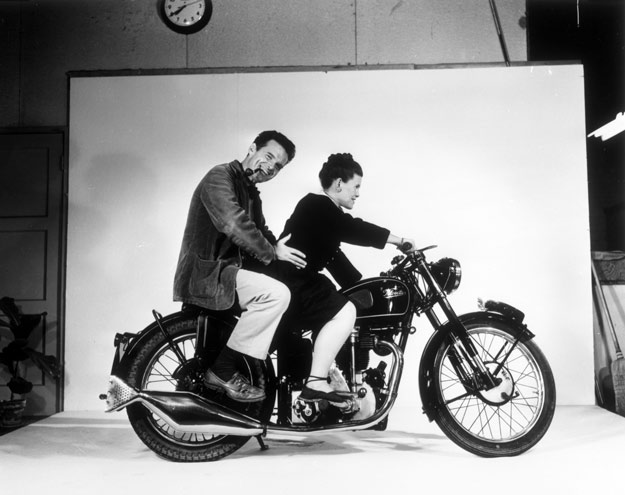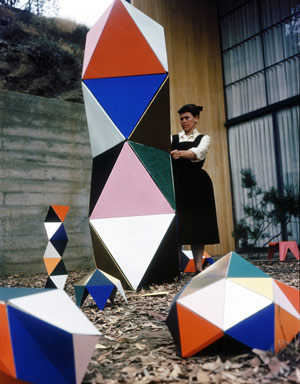 |
| Photo courtesy First Run Features |
The DVD version of Eames: The Architect and the Painter was released on December 13. |

Ray Eames with an early prototype of The Toy, made of cardboard triangles.
Even without footing in the design world, the name “Eames” is instantly recognizable. The Eames chair was such a game-changer when it was unveiled in 1956 that it has found a place—either literally or through designs it inspired—in countless homes and offices in the United States and around the world. But most of us know little about the people behind this marvel of design.
Eames: The Architect and the Painter, a documentary about Charles and Ray Eames that was released on DVD this week after opening in theaters in mid-November, is an admirable yet flawed attempt to correct that. Filmmakers Jason Cohn and Bill Jersey and narrator James Franco take us on a fairly pedestrian trip through the lives of these titans of 20th century art and design. They hit the landmarks—the genesis of the Eames chair, the invigorating, almost avant-garde filmmaking, the potentially ruinous personal struggles with misogyny and adultery—but we’re left with the impression that the filmmakers want the film to be as unchallenging as possible.
On one hand, it’s visually unambitious. Cohn and Jersey follow a rote structure of interview-primary source material-interview. They show hints of daring when they use archival photos and footage to build a virtual shrine to the Eames’ lives as if assembling a piece of their furniture. But moments like this are few and far between, and the film has an overall tepid, PBS-like quality. (Coincidentally, Eames is presented in part by the American Masters series.) This is unfortunate for a documentary about such visually exciting and boundaries-pushing artists.
Worse, the film’s scope is far too limited. We’re given the full run of the Eames’ lives and careers, but it’s all surface. The big moments are handled well and with some degree of depth. But most of the film’s compelling information whizzes by like bullet points. This is especially egregious when the filmmakers become enamored with the charismatic Charles, which thrusts him to the center of the film and pushes Ray to the margins. We’re teased with revelations—how her creativity took a back seat to Charles’, how she was denied credit on some of the Eames’ biggest projects by a misogynist system and work culture, how she was the backbone of the Eames studio—only to have them dropped quickly to return to Charles’s story. The filmmakers try to give Ray the recognition she deserves at the end of the film, but it comes off as shallow lip service.
Ray Eames is every bit as interesting as Charles, but she gets short shrift because there simply isn’t enough time to fully deal with her. The artistry, creativity, and cultural importance of the Eameses demand a four-hour, incisive investigation. Eames, at 82 minutes, is merely an outline. The film succeeds in presenting a wide audience with a wide view of the Eames legacy, but far too much falls by the wayside in the name of mass appeal.



Post a comment to this article
Report Abusive Comment